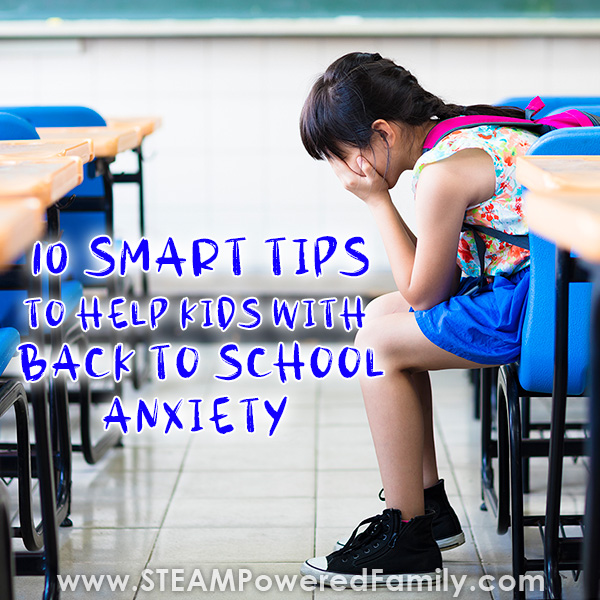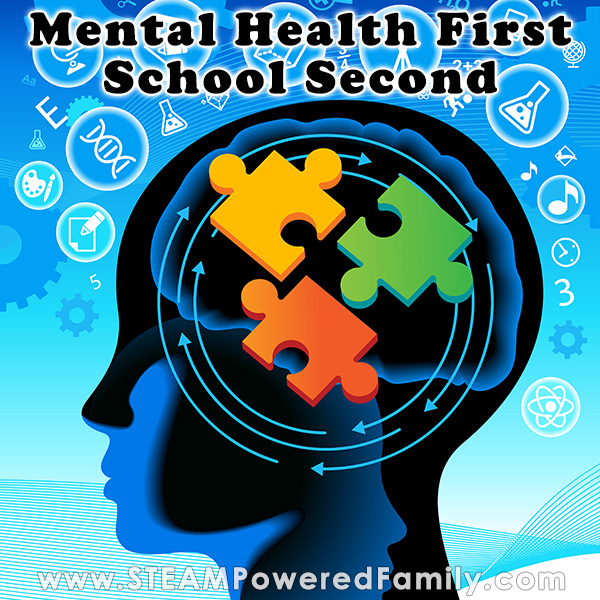Back to School Anxiety
Back to school anxiety can feel overwhelming for many kids, parents and even teachers. If not addressed correctly from the very beginning, it can quickly spiral into ongoing anxiety, school stress, school refusal, behavioural problems and more. Here are some of our top tips to help alleviate the anxiety and setup students for year long success.
10 Tips to Help Students with Back to School Anxiety

Disclaimer: This article may contain commission or affiliate links. As an Amazon Influencer I earn from qualifying purchases.
Not seeing our videos? Turn off any adblockers to ensure our video feed can be seen. Or visit our YouTube channel to see if the video has been uploaded there. We are slowly uploading our archives. Thanks!
As companies begin to advertise clothing specials and back-to-school supplies, emotions are all over the place. Parents, students, and teachers are excited, nervous, and anxious.
There is so much excitement over the new box of crayons or the latest shoes, but there is also an abundance of nerves over the unknown. Students may not know their new teacher, new classmates or schedules. Or maybe they are starting in a new school.
By trying out different strategies, parents can help calm nerves and transition children through all the bumps and into a smooth and successful academic year. As we always say, we need to address mental health first, school second.
Working together, and with a bit of proactive planning, we can help kids navigate the back to school worries and put them on a path to success.
Be Excited
Children, especially younger ones, base their feelings on the emotions of those around them. If they see parents/guardians being nervous about the school year, they will be nervous as well. However, if parents act excited about returning to school, these feelings will help children look at going to school in a positive light. If possible, allow children to help pick out supplies. For younger children, this may be a bookbag/lunchbox to increase this excitement. For older tweens and teens, this could be back to school clothes. These items can also help bring comfort as your kids get on the bus or dropped off on the first day of school.
It is okay to be nervous about your children returning to school! Have these conversations with a spouse or loved one when children are not around to avoid increasing their anxious feelings.
Once school has started, teachers can foster an excitement for school and the classroom by coming up with innovative ways for kids to share their classroom experience with parents. One way is to have students create a virtual tour, this is a fantastic way to incorporate STEM into your classroom.
Finding fun and engaging back to school activities can make the classroom feel welcoming and provide students with a feeling of safety and inclusion. Developing that trust is so important. We have a list of Back to School Activity ideas here for you.
Honesty is the Best Policy
As the first day approaches, listen to your child and the specific concerns. While some students are anxious over a new teacher, others are anxious over learning the layout of a new building. Instead of saying “Oh, you’ll be fine!” take some time to talk about the concerns. A few conversations over the fears can take away so many of the anxious feelings. These conversations may need repeated during the first few weeks of school as well while children are still learning routines.
If your school has been impacted by health restrictions avoid blanket statements, such as “There is nothing to worry about.” For students in many countries, there is something to worry about. A new normal has formed with temperature checks and masks. Instead of only reassurance, focus on honesty. If there is honesty on why washing hands for the appropriate amount of time is important or why some students are eating in classrooms instead of cafeterias, students will begin to understand why precautions are in place and eventually adjust to seeing this “new normal” without as many anxious feelings.
Foster Independent Skills
Anxious feelings can be very different based on age. For older children, they may be anxious over switching classes and finding the way around a building. For younger children, they may be anxious about not knowing who is going to help them when parents are not around. Prior to the school year, it can be helpful to spend time practicing ways to tie shoes, zipping up jackets, and opening snack containers. If these issues arise in school and children are not prepared, so many anxious feelings can come at once. However, if children may be able to complete these items by themselves, they may not worry as much. If your child is unable to do some of these items before school starts, just let them know it is okay to ask for help.
Practice Routines
During summer, students often get off the traditional school schedule. Bedtimes get pushed back, eating occurs at different times, and there is no homework to worry about. It can be very helpful to set up a school routine about a week or two before school starts. Before the back to school anxiety starts kicking in. Practice going to bed at an earlier time and waking up at the required time for school. Being well rested will help to reduce upset feelings that may arise during drop off. It can also be helpful to set out clothes at night for the next day to build this into a routine. By doing this, the morning may be much smoother and can help lessen back to school anxiety.
For older students, it may take longer for them to adjust to new bedtimes and wake up times. Especially if one is up late playing video games. The adjustment time will be different for each person, but a week or two will be helpful without losing too much summer fun.
One of the biggest challenges for elementary students can be eating in a short time frame. Practice opening food items and eating in the same amount of time that school allows. No one wants to have a hungry stomach while learning for several more hours. This will also help parents/guardians see what containers work and what food works best. There will be staff members around to help at lunch, but the lunch period is short. It is important to have food and drink items that can be consumed right away.
Communication
Regardless of the age of your children, communication with staff members can be vital. If your child is anxious, reach out to the teacher and let him/her know. Before students arrive, teachers are back in their classrooms and can be reached via email or phone. By doing this, the teacher can reach out to the student or just be on the lookout for general signs of worry and anxiety in the classroom.
Calming Strategies
As students get older, they can begin to learn calming techniques on how to deal with anxious situations. Before school starts, talk to your child about breathing exercises and how to slow down breathing in an anxious situation. In addition to this, talk to your children how it is okay to reach out to a teacher or staff member for help if they cannot get their breathing or nerves calmed down. It is important for students to know it is okay to feel worried or anxious and to let someone know if breathing techniques do not work. The anxiety will only increase if students do not have strategies to work on it.
Pro Tip! – We have created a resource for teachers packed full of strategies to help with anxiety in the classroom. Review it and put some of those strategies into place to help students become self sufficient in addressing their emotional needs both at school and at home.
Review Plans in Advance
Before school starts, it is helpful to review plans with students. For parents, this can mean looking through the school handbook together, attending a Back-to-School night, or walking through the school together. By doing this, students understand the day-to-day schedule and become familiar with the rules. This way they will not have to worry as much. It is also important to talk about pick up plans for the end of the day. If a child has to sit worried about getting on the bus or who is picking him/her up, then the entire day may be filled with anxious feelings.
Visual Supports
Anxiety can increase greatly when students don’t know what to expect. As a parent, think of the nerves of starting a new job and being unsure of what to wear, where to go, and what to expect. This is the same for children but multiplied greatly due to the young age and unfamiliarity with the unknown. For younger students, visual reminders may be helpful, such as what to do before bed: go to the bathroom, brush teeth, lay out clothes for tomorrow, and pack a backpack. For teachers, this can mean a visual schedule posted in the classroom to help students know what to expect next, such as a breakdown of the day: morning routine, math, lunch, recess, reading, specials. By having visual aids, children have consistent reminders and can breathe easier knowing what is next or what is expected.
One thing I do for my older student is to create a table of his class schedule which is colour coded, ( I do this in Word). On the back, I include important details like student number, home room, locker number, and contact information. After printing off a copy for each of his binders, we slide it, schedule side out, into the front clear plastic pocket of each of his binders. This way he always has that information with him. Using the front pocket also gave him the idea to use that as a place to slide notes to remind himself of important things. It has really helped calm his anxiety. Especially during those first few weeks when back to school anxiety is high as he learns his schedule and school routines.
Ways to Say Goodbye
Leaving parents can be tough to do! Since this is one of the first aspects of going to school, it is important to set up a smooth goodbye routine. If your child is emotional, drawing out a long goodbye can make for a more emotional day. Prior to school starting back, work on developing a goodbye routine. This might be a cool handshake, hug and kiss, or high five, anything that works for you and your little one! If drop off occurs at the classroom door, try not to draw out the goodbye. Once goodbyes have been said and your child is with the teacher or in his/her seat, quietly leave. Making your exit quietly and efficiently will help avoid upsetting your child. For older kids who are anxious about leaving home, send them off with a note in their lunch or a quick text to say you’re thinking of them.
Get Organized
To help reduce stressful mornings, being organized is important. Have a set spot for lunchboxes, bookbags, and shoes. By being organized, children will learn the routine and know what to do each morning. In addition to this, it can be helpful to have lunches and snack items organized if packing food each morning.
The first few weeks of school may bring a huge adjustment no matter the age of students. Back to school anxiety is completely normal for students of all ages. By following the above suggestions, children/teens and parents/guardians can have a more enjoyable transition to school. As time progresses, a solid routine will be formed and children will be ready to learn and socialize with friends.






